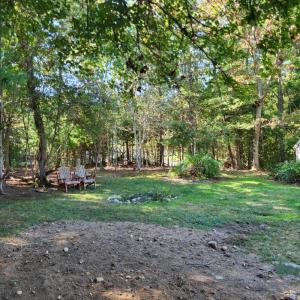Not so set in stone: Wareham artist recreates rock art from thousands of years ago
 Eric Lintala’s “Spirit Helper with Medicine Bag” piece inspired by rock art in California. Photo by Bobby Grady
Eric Lintala’s “Spirit Helper with Medicine Bag” piece inspired by rock art in California. Photo by Bobby Grady Lintala’s work bench and the tools he uses. Photo by Bobby Grady
Lintala’s work bench and the tools he uses. Photo by Bobby Grady Lintala’s “studio” consists of a stool and a vice. Photo by Bobby Grady
Lintala’s “studio” consists of a stool and a vice. Photo by Bobby Grady Lintala poses with one of his pieces. Photo by Bobby Grady
Lintala poses with one of his pieces. Photo by Bobby Grady “Snake Canyon Shaman” combines Lintala’s recent work with his old work. Photo by Bobby Grady
“Snake Canyon Shaman” combines Lintala’s recent work with his old work. Photo by Bobby Grady “Shaman Of The Swamp” is inspired by rock art in Southeastern Utah. Photo by Bobby Grady
“Shaman Of The Swamp” is inspired by rock art in Southeastern Utah. Photo by Bobby Grady “Icarus’ Last Song” shows a piece of rock art the reminded Lintala of the story of Icarus. Photo by Bobby Grady
“Icarus’ Last Song” shows a piece of rock art the reminded Lintala of the story of Icarus. Photo by Bobby Grady “Flight AA5342 Life From Death Homage to Chris Collins” pays respect to Lintala’s close friend who passed away in a Washington D.C. plane crash. Photo by Bobby Grady
“Flight AA5342 Life From Death Homage to Chris Collins” pays respect to Lintala’s close friend who passed away in a Washington D.C. plane crash. Photo by Bobby Grady Lintala poses with a piece of rock art in Wyoming. Source: Eric Lintala
Lintala poses with a piece of rock art in Wyoming. Source: Eric Lintala Lintala with more rock art in Texas. Source: Eric Lintala
Lintala with more rock art in Texas. Source: Eric Lintala Lintala’s wife and daughter casted their own shadow on a rock which Lintala turned into a sculpture. Source: Eric Lintala
Lintala’s wife and daughter casted their own shadow on a rock which Lintala turned into a sculpture. Source: Eric Lintala Eric Lintala’s “Spirit Helper with Medicine Bag” piece inspired by rock art in California. Photo by Bobby Grady
Eric Lintala’s “Spirit Helper with Medicine Bag” piece inspired by rock art in California. Photo by Bobby Grady Lintala’s work bench and the tools he uses. Photo by Bobby Grady
Lintala’s work bench and the tools he uses. Photo by Bobby Grady Lintala’s “studio” consists of a stool and a vice. Photo by Bobby Grady
Lintala’s “studio” consists of a stool and a vice. Photo by Bobby Grady Lintala poses with one of his pieces. Photo by Bobby Grady
Lintala poses with one of his pieces. Photo by Bobby Grady “Snake Canyon Shaman” combines Lintala’s recent work with his old work. Photo by Bobby Grady
“Snake Canyon Shaman” combines Lintala’s recent work with his old work. Photo by Bobby Grady “Shaman Of The Swamp” is inspired by rock art in Southeastern Utah. Photo by Bobby Grady
“Shaman Of The Swamp” is inspired by rock art in Southeastern Utah. Photo by Bobby Grady “Icarus’ Last Song” shows a piece of rock art the reminded Lintala of the story of Icarus. Photo by Bobby Grady
“Icarus’ Last Song” shows a piece of rock art the reminded Lintala of the story of Icarus. Photo by Bobby Grady “Flight AA5342 Life From Death Homage to Chris Collins” pays respect to Lintala’s close friend who passed away in a Washington D.C. plane crash. Photo by Bobby Grady
“Flight AA5342 Life From Death Homage to Chris Collins” pays respect to Lintala’s close friend who passed away in a Washington D.C. plane crash. Photo by Bobby Grady Lintala poses with a piece of rock art in Wyoming. Source: Eric Lintala
Lintala poses with a piece of rock art in Wyoming. Source: Eric Lintala Lintala with more rock art in Texas. Source: Eric Lintala
Lintala with more rock art in Texas. Source: Eric Lintala Lintala’s wife and daughter casted their own shadow on a rock which Lintala turned into a sculpture. Source: Eric Lintala
Lintala’s wife and daughter casted their own shadow on a rock which Lintala turned into a sculpture. Source: Eric LintalaInside an unassuming Dartmouth shed hangs recreations of ancient rock art detailing the world tens of thousands of years ago. The metal recreations made by Eric Lintala aim to keep the history behind the drawings alive as they succumb to time.
“I’m an artist and I look at the depictions as art,” Lintala said. “It moved me so much I’ve almost stopped going to museums to look at work.”
Lintala has lived in Wareham since 2006 and is a former sculpture professor at UMass Dartmouth. On Saturday, Aug. 16 and Sunday, Aug. 17, he and his former student Bruce Bailey put on a gallery at Bailey’s studio as part of the South Coast Open Studio Tours, an event where artists in Dartmouth, Little Compton, Westport and Tiverton open their studios to visitors.
Lintala has spent many years studying ancient rock art and the imagery within it which he recreates in metal.
“I’m just trying to bring back the way they communicated using contemporary materials like steel and bronze,” he said. “It’s about keeping this kind of communication and what they created alive because a lot of that work is disappearing.”
Lintala added he revisits many of the sites that have inspired him and he has seen the deterioration of the ancient carvings firsthand.
“You’ve got some cave paintings that have lasted some 12,000 years but when somebody goes along and puts their hand on it, the oil from their hands starts to create bacteria on the painting,” he said.
Going back to his childhood, Lintala said he has always had a fascination with archaeology and similar Earth sciences which he got to deepen as an adult. In his international travels, Lintala has visited many ancient rock art sites.
Lintala’s first rock art expeditions took place in Europe where he learned of the Vikings’ petroglyphs. He continued to follow different ancient civilizations’ work from there until he hit the canyons of the American Southwest.
“I’ve seen stuff on those walls that just blows me away,” he said. “It’s more contemporary than what I’ve seen in the museums nowadays.”
What Lintala saw were ancient depictions of the world at the time featuring animals, people and the gods they worshipped, some of which he discovered in South Creek Canyon in Utah.
“I was scanning the cliffs with binoculars looking for petroglyphs and the sun was starting to move and all of a sudden, this image appeared and it’s not even 20 seconds before it disappears,” he said. “It took me a while to get out to the site and it was obvious no one had been there since the image was carved.”
After photographing and recording the site, he sent his findings into the state of Utah’s archaeology department who confirmed with the national government the site had not been recorded.
Behind every piece of rock art is an unknown meaning which Lintala said is what has captivated him for so many years.
“One of the most popular yet confusing images is a line of small figures and they’re all waving at you, what the hell are they waving at,” he said. “It really makes you question what was going through their heads because they weren’t influenced by anything except the nature that was around them.”
Despite not knowing the exact meaning behind the images, Lintala often puts his own interpretation on them.
“I call this one “Icarus” because it reminds me of the myth of flying too close to the sun,” Lintala said of one of his sculptures.
In order to recreate each image, Lintala has a long process to ensure his design matches the rock art.
“I photograph all the rock art myself and I’ll project them onto cardboard to create a pattern so they’re virtually identical,” he said. “If these people were to come back they could still read these things and that’d be great cause then I can figure out exactly what they’re trying to say.”
Lintala’s artwork has not always included ancient images, he said. For a number of years, Lintala’s work focused on creating large, geometric shapes out of metal which he is now combining with his most recent work.
“Now the shapes have some content to it that I’m bringing forward in time,” he said.
















































